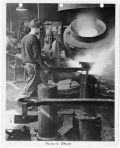
Calumet & Hecla - Wolverine Tube Division |
Metal Trade, Copper Industry and Trade, Manufacturing Process, Manpower, Labor, Skilled Labor |
Pouring Brass. Brass casting furnace. Using the electric induction principle the charge is heated to pouring temperature. The charge is being poured through a conical runner box into a vertical mold which is water cooled. The operator has a feeler rod in his hand and is ready to tilt the furnace back to melting position when the mold has been filled. The molds for each pair of brass furnaces are rotated on a turntable.
Scanned: September 28, 2009 |
|

Calumet & Hecla - Wolverine Tube Division |
Metal Trade, Copper Industry and Trade, Manufacturing Process, Manpower, Labor, Skilled Labor |
Removing billet from mold. After the metal has cooled, the mold is tilted to a horizontal position and the plug shown in the lower left is removed from the bottom. A hydraulic rod pushes the billet from the mold where it is grabbed by the man with tongs and removed. It is turned 90 degrees and placed on the conveyor shown at the right which carries it under the floor to a water quench bath. The center of the picture shows one of the swabs which is used to dress the interior of the mold prior to the next casting operation.
Scanned: September 28, 2009 |
|

Calumet & Hecla - Wolverine Tube Division |
Metal Trade, Copper Industry and Trade, Manufacturing Process, Manpower, Labor, Skilled Labor |
Inspection of blocks. An inspector is examining both ends and the surface of each of the blocks before passing them on to be converted into base tubing. Removal of blocks which have porosity either at the surface or center is assured by this method. The Chemical Laboratory control insures for each billet an analysis which will meet the specifications for which it is intended. Rejections are immediately returned to the metal shed and are melted up and re-cast.
Scanned: September 28, 2009 |
|

Calumet & Hecla - Wolverine Tube Division |
Metal Trade, Copper Industry and Trade, Manufacturing Process, Manpower, Labor, Skilled Labor |
Rotary Reheat Furnace is designed to bring the block up to a predetermined extrusion temperature. The furnace is gas fired and the blocks are heated in an atmosphere from which all free oxygen has been removed. The furnace is controlled by the panel shown at the left of the picture.
Scanned: September 28, 2009 |
|

Calumet & Hecla - Wolverine Tube Division |
Metal Trade, Copper Industry and Trade, Manufacturing Process, Manpower, Labor, Skilled Labor |
Extrusion Press - Close up view of the press. A heated block has just passed along the track at the bottom of the picture and has been dropped into the container. The pin has started to enter the block and will be followed by the head causing the hot metal to be forced through the die and over the pin, which is travelling slowly through the center of the die at the bottom of the container, and to merge in the shape of a tube.
Scanned: October 6, 2009 |
|

Calumet & Hecla - Wolverine Tube Division |
Metal Trade, Copper Industry and Trade, Manufacturing Process, Manpower, Labor, Skilled Labor |
Piercing Mill - Known as piercing, in this process approximately 50" long billets are heated in a furnace. The hot billet is discharged from the heating furnace into the trough behind the piercing mill and forced hydraulically between two rollers which rotate the billet at a speed previously determined as the most efficient. This causes the hot billet to travel forward and over a point which helps to produce and dresses the inside diameter of the base tube. After the entire billet has been pierced and the tube is on the mandrel rod, the rod is withdrawn and the tube removed from the mill by an ejector mechanism which carries it down a roll conveyor and into a quench bath.
Scanned: October 6, 2009 |
|

Calumet & Hecla - Wolverine Tube Division |
Metal Trade, Copper Industry and Trade, Manufacturing Process, Manpower, Labor, Skilled Labor |
Base Tube Inspection - Base Tubes are inspected for both surface defects and dimensions.
Scanned: October 6, 2009 |
|

Calumet & Hecla - Wolverine Tube Division |
Metal Trade, Copper Industry and Trade, Manufacturing Process, Manpower, Labor, Skilled Labor |
Large Drawbench - Photo showing a view of the head of one of the larger of the draw benches in the mill.
Scanned: October 6, 2009 |
|

Calumet & Hecla - Wolverine Tube Division |
Metal Trade, Copper Industry and Trade, Manufacturing Process, Manpower, Labor, Skilled Labor |
Sawing To Length - Tubes which have been drawn to the finished size are being cut on band saws to the finished length.
Scanned: October 6, 2009 |
|

Calumet & Hecla - Wolverine Tube Division |
Metal Trade, Copper Industry and Trade, Manufacturing Process, Manpower, Labor, Skilled Labor |
Final Inspection - Inspector is examining the inside surface, of the length of coiled tubing. He has made an angle cut, and depending on its appearance will pass the tube on for further handling or reject it. He has been trained to lift the tube away from the saw in such a way as to prevent saw chips from falling inside the tubing.
Scanned: October 6, 2009 |
|